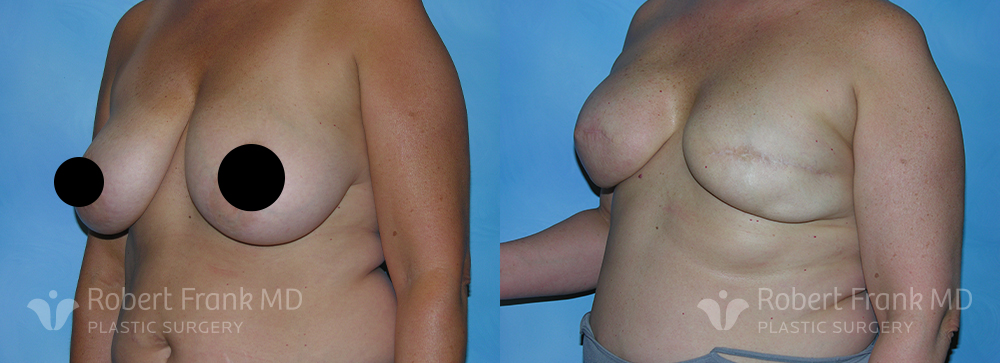
For many women after a mastectomy, restoring their appearance is part of their physical and personal recovery. Through breast reconstruction, Robert Frank, MD Plastic Surgery helps patients from Hobart, Munster, Crown Point, and Frankfort regain what they have lost. He helps those in his care achieve this result through a supportive bedside manner, years of experience, and careful coordination with general practitioners and general surgeons.
Dr. Frank’s Approach to Breast Reconstruction
Our practice follows one of two paths depending on the patient’s needs:
- If she has not yet had a mastectomy, Dr. Frank works in concert with the patient’s medical team to plan and perform breast reconstruction (immediate reconstruction).
- If she has already had a mastectomy, Dr. Frank conducts the surgery as a second, follow-up procedure.
In either case, our practice helps breast reconstruction patients in Hobart, Munster, Crown Point, and Frankfort work with their insurers. Companies will often cover at least a portion of the expense, and we can guide patients through the process.
There are many different types of breast reconstruction procedures. Some require taking skin and muscle from elsewhere on the body, which means a longer hospitalization and recovery. As an alternative, most of Dr. Frank’s patients have tissue expander implant surgery. This method is a multi-stage process that creates new tissue in the area of the mastectomy and builds volume with an implant.

View the Breast Reconstruction Gallery
About the Procedure and Recovery
Phase One
For women who have not yet had a mastectomy, breast reconstruction takes place during the same surgical session:
- The general surgeon conducts the mastectomy.
- Dr. Frank performs the initial reconstruction and places the tissue expander.
- Both procedures take place while the patient is under general anesthesia, so she wakes up already on her way to a restored body.
For breast reconstruction patients from Munster, Hobart, Crown Point, and Frankfort who have already had a mastectomy, Dr. Frank places the expander as an outpatient procedure. Typically, these patients have less discomfort during recovery.*
In both cases:
- Patients return to Dr. Frank’s office several times in the weeks that follow.
- After about two weeks, most women have drains removed from the surgical site, and Dr. Frank can begin the expansion process.*
- About once per week over a period of 6-8 weeks, our practice adds volume to the expander using an accessible port.*
Throughout recovery, Dr. Frank encourages patients to share how they are feeling about the shape and size of their growing breast tissue. This allows him to tailor the next phases of breast reconstruction to their needs.
Phase Two
After a patient’s breast tissue has reached the appropriate size, she schedules a follow-up procedure with Dr. Frank to receive a permanent breast implant. The surgery takes place at a licensed facility under general anesthesia.
Dr. Frank uses Mentor® and Inamed® implants, which offer generous warranties and have proven their safety over time. A sizeable majority of his patients choose silicone gel implants for their softer, more natural feel. Mastectomy patients may not have the right amount of breast tissue for saline implants, which require enough mass to look and feel natural.
Phase Three
Breast reconstruction concludes with a third procedure that reconstructs the nipple and areola for better aesthetics. Patients usually receive sedation rather than general anesthesia.
One of the benefits of this procedure is that patients can donate skin for the nipple from an area that has too much skin. For example, some mastectomy patients notice that the armpit area has become enlarged with tissue, and so the procedure improves this concern as well as creates a more natural-looking breast.
Usually, the final results of breast reconstruction appear 6-8 months after Phase Two.* This gives the breast time to settle into position. Though the entire process takes time, breast reconstruction helps restore the patient’s body, eliminates her need to wear a removable prosthetic breast, and makes many women feel whole again.*
Dr. Frank’s Advice on Recovery
We all have our own ideas of how long recovery should take. Unfortunately, this means many patients try to rush their recovery and go back to normal activities. This trend is especially true among young mothers who want to spend every moment with their children. They may attempt to play with or pick up their children before their bodies are ready to handle that strain.
Dr. Frank sees rushed recoveries in several ways, with one of the most common being pain. Patients who try to be too active too early in the recovery process often find themselves running through their pain medication too soon and have to ask for an early refill. Rather than increase the amount of medication you take, you will feel better sooner and end the period wherein you need the medication faster if you allow your body to rest. Do not force your body to undergo more physical strain than it is ready to handle. It is okay to take 30-minute breaks on the couch.
Another way Dr. Frank sees patients push themselves too hard is an increased risk of both swelling and dangerous hematomas.
For example, after liposuction, your body needs time to move fluid out of your skin. Patients who have had liposuction will have skin that feels firmer than untreated areas because of this fluid buildup. Getting that fluid out of your skin is one of your recovery goals during the weeks after surgery. But if you activate your muscles near the treated area, that activity draws fluid into the area, which increases swelling and often pain. In the case of a tummy tuck, too much activity early in your recovery can increase blood pressure, which then causes more oozing into the space created during surgery. While a little fluid is normal, it’s easy to overwhelm your body’s ability to absorb this fluid. A hematoma is the result.
To minimize these concerns, Dr. Frank encourages all patients to clear their schedules of everything except the most essential duties for the two weeks after surgery. You should minimize the amount of childcare, job responsibilities, meetings, social activities, and home chores in which you partake so your body can rest. You will feel better and recover faster if you plan ahead so that your body, not your calendar, determines when you are ready for your physical activities.
To rejuvenate your body after mastectomy, schedule a breast reconstruction consultation with Robert Frank MD, Plastic Surgery. Patients from Munster, Hobart, Crown Point, and Frankfort can schedule online or call our practice at (219) 513-2011.
*Individual results may vary